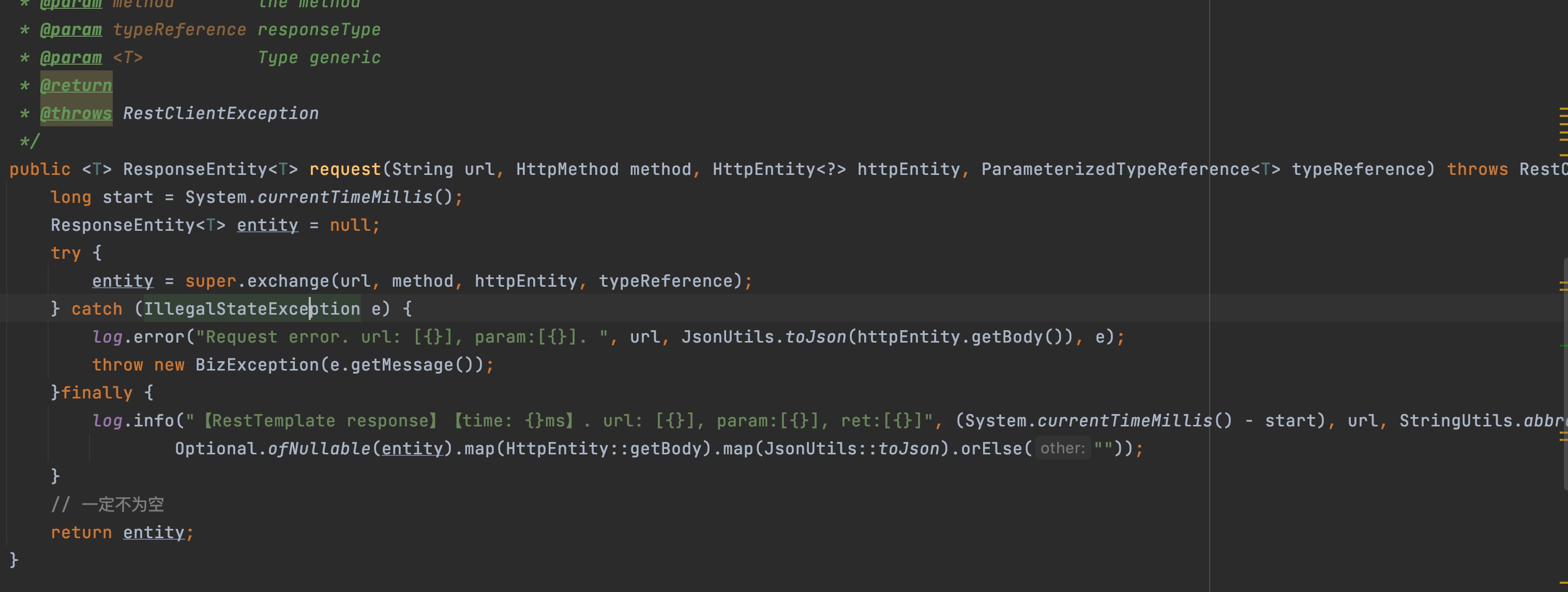背景
现在随着微服务的逐渐发展,越来越多的公司开始采用微服务架构,但随之而来的问题是,服务间如何调用,如何还能负载均衡,还必须开箱即用?答案就是Spring的RestTemplate啦(并不一定要使用RestTemplate,也不一定要是微服务架构,涉及到Http调用的服务,方式都可以,我这个是为了引出主题),但伴随而来的是一个问题,如何打印好日志,留下现场(防止扯皮),这才是我们关心的。这也是我们这篇文章的主题-RestTemplate打印日志的正确姿势。好了,不凑字数了,接下来进入正文。
1. 老实人干事
作为一个老实人,对于打日志这类请求,就是通过代理,找出核心方法,在方法后,打印日志参数即可。实时,我也就是这么做的,如下图:

我把RestTemplate的最底层方法进行了包装,然后在执行后,返回结果前但因日志。这样做,说实话,没毛病,并且我拿去运行,放在线上运行了好长一段时间,没出任何问题。但是..但是...,现实就是偏偏就欺(bu)负(xi)老(xin)实(ren)人(zhen)
2. 老实人翻盘
为什么说是欺(bu)负(xi)老(xin)实(ren)人(zhen)呢?最近我在看代码的时候,发现了ResTemplate提供了一个方法RestTemplate#setInterceptors,我们通过名称就知道,是设置拦截器的。只看名称,那还不一定,我们需要去瞅瞅源码才行。
2.1 源码追踪
setInterceptors方法如下:
// 设置拦截器
public void setInterceptors(List<ClientHttpRequestInterceptor> interceptors) {
// Take getInterceptors() List as-is when passed in here
if (this.interceptors != interceptors) {
this.interceptors.clear();
this.interceptors.addAll(interceptors);
// 对拦截器进行排序
AnnotationAwareOrderComparator.sort(this.interceptors);
}
}
setInterceptors逻辑很简单,就是添加拦截器。我们接下来要看看拦截器是在哪里使用的,这也是我们需要确认的点。接着往下。
// 构建RequestFactory
public ClientHttpRequestFactory getRequestFactory() {
// 获取拦截器
List<ClientHttpRequestInterceptor> interceptors = getInterceptors();
if (!CollectionUtils.isEmpty(interceptors)) {
// 拦截器不为空
ClientHttpRequestFactory factory = this.interceptingRequestFactory;
if (factory == null) {
// 使用拦截器构建的RequestFactory
factory = new InterceptingClientHttpRequestFactory(super.getRequestFactory(), interceptors);
this.interceptingRequestFactory = factory;
}
return factory;
}
else {
// 返回默认的 SimpleClientHttpRequestFactory,可以自己查看一下
return super.getRequestFactory();
}
}
在getRequestFactory中搜寻到了拦截器的使用,是通过拦截器,构建了一个InterceptingClientHttpRequestFactory对象。目前,我们通过名字大意可以看到,是构建了一个拦截器的请求工厂,但还是没有具体信息,让我们接着往下,看看这个InterceptingClientHttpRequestFactory里面是怎么使用的。
省略中间简单的逻辑,我们找到了最终逻辑。在InterceptingRequestExecution源代码如下:
private class InterceptingRequestExecution implements ClientHttpRequestExecution {
private final Iterator<ClientHttpRequestInterceptor> iterator;
public InterceptingRequestExecution() {
// 胡哦哦去拦截器的迭代器
this.iterator = interceptors.iterator();
}
@Override
public ClientHttpResponse execute(HttpRequest request, byte[] body) throws IOException {
if (this.iterator.hasNext()) {
ClientHttpRequestInterceptor nextInterceptor = this.iterator.next();
//每次将当前对象传入,循环迭代调用拦截器
return nextInterceptor.intercept(request, body, this);
}
else {
// 当拦截器执行完,开始执行请求逻辑
HttpMethod method = request.getMethod();
Assert.state(method != null, "No standard HTTP method");
ClientHttpRequest delegate = requestFactory.createRequest(request.getURI(), method);
request.getHeaders().forEach((key, value) -> delegate.getHeaders().addAll(key, value));
...
// 执行请求,并返回执行结果对象。ClientHttpResponse
return delegate.execute();
}
}
}
在执行execute方法时,循环调用拦截器方法。当拦截器执行完后,构建请求对象,执行请求。请求执行完,返回请求结果对象。
3. 拨开迷雾
源码看我我TM悟了,原来别人提供了拦截器,我还自己搞那么复杂。这不是吃力不讨好吗?那不行,我的改造我的代码。
3.1 实现拦截器接口-ClientHttpRequestInterceptor
贴上我写的代码,如下所示:
/**
* <br>日志拦截器</br>
*
* @author fattyca1
* @since 1.0
*/
@Slf4j
public class LoggingRequestInterceptor implements ClientHttpRequestInterceptor {
// 用来记录接口执行时间的最小接收值
private final long timeoutMs;
public LoggingRequestInterceptor(long timeoutMs) {
this.timeoutMs = timeoutMs;
}
@Override
public ClientHttpResponse intercept(HttpRequest request, byte[] body, ClientHttpRequestExecution execution) throws IOException {
long start = System.currentTimeMillis();
ClientHttpResponse response = execution.execute(request, body);
long cost = System.currentTimeMillis() - start;
if (cost > timeoutMs) {
log.warn("Request uri: [{}], Cost times: {}ms", request.getURI(), cost);
}
// 打印日志
trace(request, body, response);
return response;
}
private void trace(HttpRequest request, byte[] body, ClientHttpResponse response) throws IOException {
// 记录日志
String responseStr = IOUtils.toString(response.getBody(), StandardCharsets.UTF_8);
log.info(
"
" +
"URI : {},
" +
"Method : {},
" +
"Headers : {},
" +
"Param : {},
" +
"RespStatus : {},
" +
"Response : {}", request.getURI(),
request.getMethod(), request.getHeaders(), new String(body, StandardCharsets.UTF_8), response.getStatusCode(), responseStr);
}
}
代码逻辑很简单,实现拦截器,在拦截器中执行请求的时候,根据入参,出参,并打印结果。
3.2 构建RestTemplate对象
构建RestTemplate对象代码如下所示:
private RestTemplateWrapper buildHttpRestTemplate(CloseableHttpClient client) {
RestTemplateWrapper restTemplate = new RestTemplateWrapper();
HttpComponentsClientHttpRequestFactory clientHttpRequestFactory
= new HttpComponentsClientHttpRequestFactory(client);
// 连接超时
clientHttpRequestFactory.setConnectTimeout(httpClientProperties.getConnectionTimeOut());
// 数据读取超时时间
clientHttpRequestFactory.setReadTimeout(httpClientProperties.getSocketTimeOut());
// 连接不够用的等待时间
clientHttpRequestFactory.setConnectionRequestTimeout(httpClientProperties.getConnectionRequestTimeout());
// 需要支持从response重复获取body数据
// restTemplate.setRequestFactory(new BufferingClientHttpRequestFactory(clientHttpRequestFactory));
restTemplate.setRequestFactory(clientHttpRequestFactory);
// 设置拦截器
restTemplate.setInterceptors(Collections.singletonList(new LoggingRequestInterceptor(httpClientProperties.getLogTimeoutMs())));
return restTemplate;
}
我们通过一些列操作,到了构建RestTemplate对象这,并且设置了拦截器,可以开开心心的去注入RestTemplate对象啦。
3.3 坑,你躲开了吗
大家拿着RestTemplate开开心心去使用的时候,发现了没,会出错!!! 是的,会报错!!!好气,我辛辛苦苦搞半天,还会出错,错误如下:
Caused by: java.io.IOException: Attempted read from closed stream.
出现这个错误原因,主要是因为response.getBody()只能获取一次,在后续RestTemplate获取输出转化时会再次调用response.getBody()。
// 拦截器的打印日志代码中 response.getBody() 只能获取一次,然后会关闭流,有兴趣的可以看看源码
String responseStr = IOUtils.toString(response.getBody(), StandardCharsets.UTF_8);
既然知道问题了,那我们就得修改,那怎么修改呢?经过一番查找,找出了这个类BufferingClientHttpRequestFactory,瞅瞅这个注释(我怀疑就是坑!!不然为啥正好有一个这样的包装类):
/**
* Wrapper for a {@link ClientHttpRequestFactory} that buffers
* all outgoing and incoming streams in memory.
*
* <p>Using this wrapper allows for multiple reads of the
* {@linkplain ClientHttpResponse#getBody() response body}.
*/
public class BufferingClientHttpRequestFactory extends AbstractClientHttpRequestFactoryWrapper {
}
注释中清楚地写着,可以多次调用ClientHttpResponse#getBody()。现在我们知道怎么解决这个问题了,那么就根据它的使用方法,重新构建RestTemplate对象。代码如下(上方构建RestTemplate对象中的注释打开):
private RestTemplateWrapper buildHttpRestTemplate(CloseableHttpClient client) {
RestTemplateWrapper restTemplate = new RestTemplateWrapper();
HttpComponentsClientHttpRequestFactory clientHttpRequestFactory
= new HttpComponentsClientHttpRequestFactory(client);
// 连接超时
clientHttpRequestFactory.setConnectTimeout(httpClientProperties.getConnectionTimeOut());
// 数据读取超时时间
clientHttpRequestFactory.setReadTimeout(httpClientProperties.getSocketTimeOut());
// 连接不够用的等待时间
clientHttpRequestFactory.setConnectionRequestTimeout(httpClientProperties.getConnectionRequestTimeout());
//通过BufferingClientHttpRequestFactory对象包装现有的ResquestFactory,用来支持多次调用getBody()方法
restTemplate.setRequestFactory(new BufferingClientHttpRequestFactory(clientHttpRequestFactory));
// 打印记录
restTemplate.setInterceptors(Collections.singletonList(new LoggingRequestInterceptor(httpClientProperties.getLogTimeoutMs())));
return restTemplate;
}
至此,我们在开始运行,才发行可以走的通。
4 总结
阿~ 疏通了,舒服了,代码看着也舒服了,这样才是代码的正确打开方式。这样也让我们对代码设计有的更深的了解,在设计代码时,需要预留一些接口设置,用来拓展,或方便别人。
这只是Interceptor一次小小的使用,并不代表只能用来打印日志,我们可以根据拦截器设置cookie,header信息等,都是可以的。